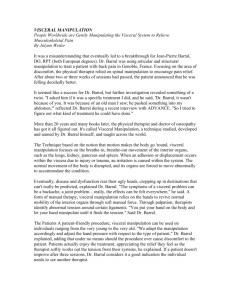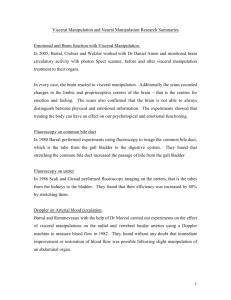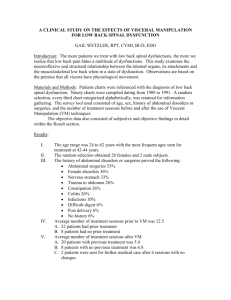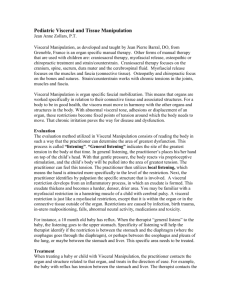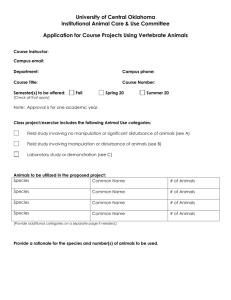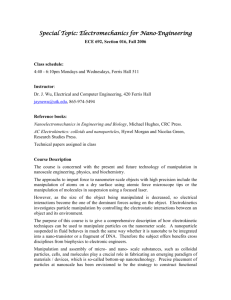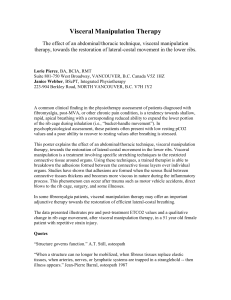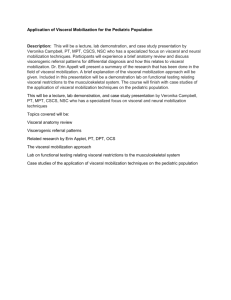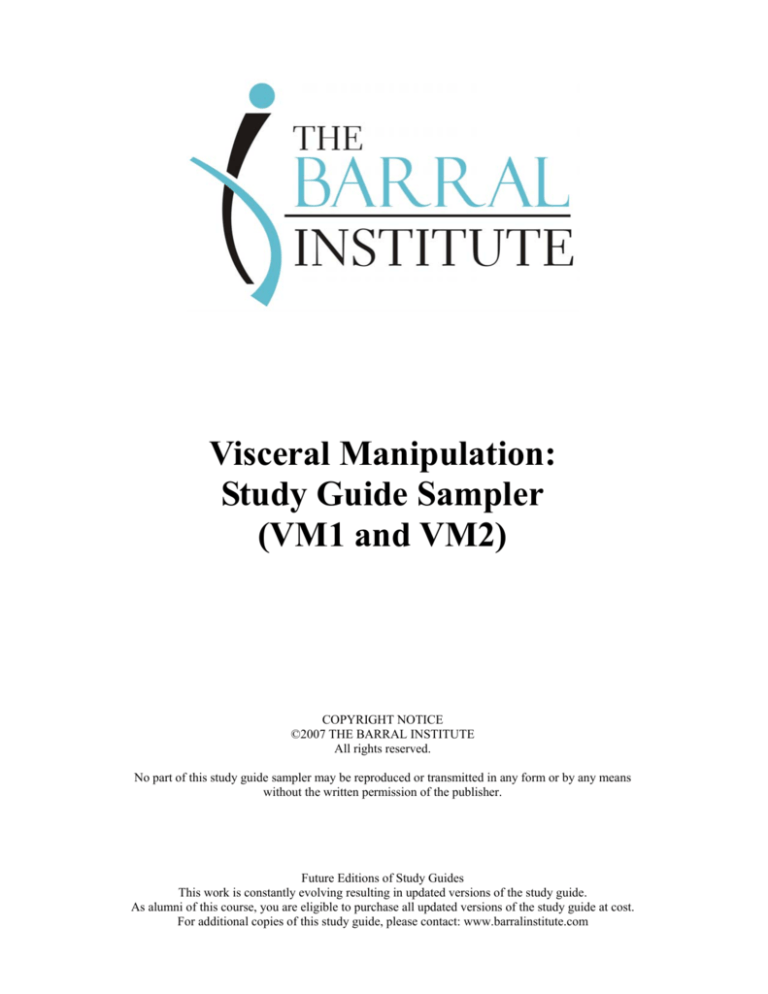
Visceral Manipulation:
Study Guide Sampler
(VM1 and VM2)
COPYRIGHT NOTICE
©2007 THE BARRAL INSTITUTE
All rights reserved.
No part of this study guide sampler may be reproduced or transmitted in any form or by any means
without the written permission of the publisher.
Future Editions of Study Guides
This work is constantly evolving resulting in updated versions of the study guide.
As alumni of this course, you are eligible to purchase all updated versions of the study guide at cost.
For additional copies of this study guide, please contact: www.barralinstitute.com
Visceral Manipulation: Abdomen 1 (VM1)
Introduction
“No one argues with the wine tester who, by using his palette, can tell us
the characteristics of a wine – its region, its vineyard or even its vintage.
The education of touch can go at least as far.”
—
Jean-Pierre Barral, D.O.
This study guide is about the education of touch. Who is better to teach us than Jean-Pierre Barral, the
developer and connoisseur of Visceral Manipulation? Jean- Pierre was born on September 25, 1944 in
Grenoble, France. He began his career as a registered physical therapist then went on to pursue a
doctorate in Osteopathy.
Working at the Lung Disease Hospital in Grenoble, he trained under Dr. Arnaud, a recognized lung
specialist and a master of cadaver dissection. Under Dr. Arnaud’s supervision, Jean-Pierre had the
opportunity to perform extensive cadaver dissections himself. What intrigued him most was the postmortem condition of body tissues in former patients. Having known these patients, treated them,
taken their medical histories and worked on their bodies, he was further able to observe the internal
condition and relate what he saw to what he felt. Jean-Pierre consistently observed extensive tissue
thickening around the viscera, which he realized was causing an altered mechanical tension on
surrounding tissues. This discovery led him to the theoretical and practical development of visceral
listening techniques.
Jean-Pierre went on to teach Spinal Biomechanics at England’s European School of Osteopathy from
1975 to 1982, all the while continuing to develop his practice. For this period of time his primary tool
was manipulation. Then one of his patients, a gentleman complaining of back pain, showed a marked
improvement, not however from his osteopathic manipulation. This patient had visited a folk healer in
the Alps who pushed something in his abdomen.
Barral noted how effective this visceral “adjustment” was to his neuromusculoskeletal problem and
pursued this direction in his research. He came to see the significant relationship between viscera and
somatic dysfunction. He discovered that structural relationships (musculoskeletal, spinal, cranial)
would self-correct after proper Visceral Manipulation. It became apparent that Visceral Manipulation
affected many body systems.
Students have been able to study Jean-Pierre’s approach to visceral manipulation and to observe his
work at the Institute symposiums, where practitioners presentdifficult cases for his evaluation and
treatment. In what appears to be a very simple examination in a very short time – a matter of minutes
– Jean-Pierre gives an accurate medical and surgical history, without exchanging a word with the
patient. He explains, “I prefer to speak to the tissues not so much the person.” He receives his
information not from telepathic connection to the patient’s mind, but from simply listening with his
hands to the story the tissues have to tell.
Barral Institute – 866.522.7725
2
What is Visceral Manipulation?
“The purpose of Visceral Manipulation is to recreate, harmonize and increase proprioceptive
communication in the body to enhance its internal mechanism for better health.”
—
Jean-Pierre Barral, D.O.
Visceral Manipulation is a manual therapy consisting of gentle, specifically placed manual forces that
encourage normal mobility, tone and inherent tissue motion of the viscera, their connective tissue and
other areas of the body where physiologic motion has been impaired.
Motion is a sign of life itself. Everything in the universe is in motion. Everythingmoves in space and
time and humans are no exception to this rule. Our bodies need movement to be healthy. This same
principle applies to every structure in our bodies including the viscera. For an organ to be healthy and
have optimal function there needs to be motion.
Tissues lose their normal motion when they become inflamed. The natural healing process involves
local disruption of normal tissue fibers and their replacement with relatively inelastic granular tissue.
It can be conceptualized as a localized drying-out of the affected tissues. Many factors can cause
tissue inflammation including: infections, direct trauma, repetitious movement, diet, environmental
toxins and emotional stress.
As a student of Visceral Manipulation you will learn tools for evaluating organ motion, in particular,
two types of movement: one motion caused by the pushes and pulls of the surrounding tissues
(mobility) and the other, the organs own intrinsic, active motion (motility). You will also learn
techniques to treat these areas of decreased/altered motion, thereby restoring better physiologic
motion, which in turn will improve the function of that organ.
Barral Institute – 866.522.7725
3
Mobility
Visceral Mobility is the movement of the viscera in response to external forces.
Voluntary movement, or involuntary movement, such as the diaphragm with
respiration or the heart beating, create these external forces that push and pull on
the viscera.
For the viscera to function properly, each organ needs to be able to glide and slide
in relationship to all the other tissues without any restrictions. A restriction, fixation
or adhesion to another structure, no matter how small, implies functional
impairment of the organ.
Motility
The viscera have an intrinsic active motion which we call motility. Visceral motility
is perceptible to the hand but requires an educated sense of touch. It is the
kinetic expression of tissues in motion. The movement of motility is individual
for each organ and traces the path of embryological development and migration.
The embryologic theory of visceral motility postulates that the axes and direction
of these motions remain inscribed in the visceral tissues. Thus, visceral motility
occurs around a point of equilibrium, oscillating between an accentuation of the
embryologic motion and a return to the original position.
The motility cycle has two phases in which the organs move toward and away
from the median axis of the body. We call these phases “expir” and “inspir”
respectively. The two phases make up one cycle of movement. The rhythm of
visceral motility is characteristically 7 – 8 cycles per minute.
Barral Institute – 866.522.7725
4
Organs
There are a number of systems that work together to support and hold the
abdominal organs in their place while still allowing for full physiologic motion.
Three of the main systems are:
1.
Double Layer System
2.
Turgor
3.
Intracavitary pressures
The double layer system occurs where two serous membranes come into contact.
All of the structures in the abdomen are wrapped in a serous membrane. The
serous fluid produced from these membranes creates a suction affect between the
two layers, which holds the two structures together while still allowing for gliding
and sliding over each other.
Turgor acts upon the hollow, intraperitoneal organs. The pressure within the hollow
organs is greater than the pressure outside of them. The hollow organs therefore
expand, occupying the maximal amount of space made available for them.
In the body, each cavity has either a positive or negative pressure. The negative
pressure of the thoracic cavity plays an important role in support of the abdominal
organs. This negative intrathoracic pressure creates an upward force on the
abdominal viscera. The force of gravity in the abdominal cavity acts against this
upward force. Together, these two opposing pressures work to maintain a dynamic
balance. The negative intrathoracic pressure is very powerful and has its strongest
affect on the organs just underneath the diaphragm, constantly attracting them
upward.
An understanding of the systems that support and hold the abdominal organs in
place helps explain why the liver, an organ that is quite heavy, is held in the right
hemi-diaphragm. The liver would not be able to maintain its position if it were
not for the attractive force of the thoracic cavity. This negative pressure of the
thorax helps to hold the liver in place.
Barral Institute – 866.522.7725
5
Peritoneum
Barral Institute – 866.522.7725
6
Treatment Considerations
1.
Visceral Manipulation is characterized by high precision and minimal force.
2.
Use soft relaxed hands and let go of any tension within your own body.
3.
Let your mind be open, aware and neutral, without any urgency to succeed.
4.
Do not blend with your client. Stay separate and objective as you treat
them. Do this both physically and mentally. You will be much more
effective this way and have more energy for it.
5.
With Visceral Manipulation a little bit goes a long way. When treating,
listen to the tissues, follow the tissues and assist them to release tension
where they are restricted. Begin this process and then let the body take
over.
6.
For each case you must tune into the patient and feel the rhythm, vitality
and resistance of the tissues you are working with. Listen and follow. We
want to stimulate the patient’s forces of auto correction. A treatment does
not finish when our treatment time is over, it continues on for days, weeks
and longer.
7.
The key to Visceral Manipulation is developing your listening skills and
your understanding of anatomy.
Barral Institute – 866.522.7725
7
Contraindications and Precautions
Using alternative or natural medicine should not mean rejecting the techniques of
conventional medicine. In case of any doubt do not hesitate to use resources; refer
out as necessary.
Contraindications – use your common sense.
1.
An acute flare up of an inflammatory process
(i.e., rheumatoid arthritis, colitis, fever)
2.
Abdominal aneurysm
3.
Bleeding ulcer
4.
Thrombosis
5.
Hemorrhage or fracture
6.
Pregnancy (can perform motility & sphincter work)
Precautions – use a lighter touch in these cases because the tissues have greater
fragility.
1.
Diabetes
2.
Patients taking anticoagulant drugs or cortisone
3.
After radiation therapy, chemotherapy
4.
Dilation of superficial veins (varicosities)
5.
Foreign body – IUD, pacemaker, stints
Barral Institute – 866.522.7725
8
Visceral Articulations of the Liver
Barral Institute – 866.522.7725
9
Liver — General Information
Vascularization
Artery: celiac trunk → hepatic artery
Vein: portal vein → hepatic vein → inferior vena cava
Innervation
Sympathetic: cord level T7-T9; through greater splanchnic nerve → celiac
plexus → hepatic plexus
afferent impulses carried through the phrenic nerve C4-C5 level
Parasympathetic: vagus nerve
General Listening
Right side bending accompanied by a slight left rotation around an axis that goes
through rib 9-10 on the right.
Local Listening
With hand on patient’s abdomen, middle finger along midline and palm on
umbilicus, one’s hand is drawn to the right hypochondrium rotating clockwise
and moving superiorly.
Emotional/Psychological
The liver is the organ of identification of one’s deep self, the root of one’s personality.
The liver reacts to the intense anguish, cyclic rage, strong fears and/or
unbearable difficulties.
Barral Institute – 866.522.7725
10
Associated Skeletal Restrictions
•
C4-5 right side or bilateral
•
Right scapula
•
Right glenohumeral periarthritis
•
Cervical/brachial plexuses and associated fascia
•
T7-10
•
R7-10 — lower ribs and right costovertebral articulations
•
Cranial base restrictions — right side
•
Frontal/nasal articulation — right side
•
Left sciatica — venous hepatic origin
•
Right sciatica — related to restrictions of:
hepatic fascia, right kidney, ascending colon
•
Right parietal, temporal and sphenoid bones
Barral Institute – 866.522.7725
11
Liver Lift/Release Mobility Evaluation
and Treatment Technique
Barral Institute – 866.522.7725
12
Liver Mobility Testing/Treatment —
Transverse Plane
Notes:
Barral Institute – 866.522.7725
13
Liver Mobility Testing/Treatment —
Transverse Plane
Anterior
Liver
Stomach
Posterior
Barral Institute – 866.522.7725
Inferior
Vena Cava
(Axis of
Motion)
14
Liver
Mobility Testing/Treatment —
Coronal (Frontal) Plane
Notes:
Barral Institute – 866.522.7725
15
Visceral Manipulation: Abdomen 2 (VM2)
Introduction
Welcome to Visceral Manipulation: Abdomen 2 (VM2). As you begin this course, you will soon
discover that it is quite different from Visceral Manipulation: Abdomen 1. Rest assured, this is
intentional. Each course in the curriculum is designed to build upon the one before it, alternating
between classes that focus on academic concepts with those that reinforce your understanding of
those concepts by stressing hands-on applications.
VM2 is a highly conceptual and experiential class. In keeping with that format, this study guide is
intended to be used as a dynamic, interactive learning tool. We have included plenty of space on
both written pages and illustrations for you to record your observations as you experience them in
class. We believe this active participation on your part helps reinforce your memory of the VM
material by involving more of your senses in the learning process.
In this course, we will assume that you have become acquainted with the feel of the different
organs and local restrictions. With this familiarity established, we can now add more information
about the manipulations by adding more whole-body involvement via the long lever techniques.
These require you to FEEL several things at once:
1. The local specific structure to be tested and manipulated.
2. The related structures, textures, tones, tensions, motions.
3. Local restrictions.
4. The tensionsthat local restrictions produce in both surrounding and distant
tissues and structures as we move the body through space.
In order to properly perform items 3 and 4, items 1 and 2 must be almost second nature to you.
(Some time will be spent in review to clear up questions and clarify your perceptions.)
This “Integration of Techniques Concept” will add a deeper understanding of direct techniques,
indirect techniques, stacking, long levers, combining and stacking long levers, and recoil.
Please note that long lever techniques incorporate increased mechanical advantage. This means that
very little force is required for them to be effective. Please respect the power of these techniques.
In order to focus on the motions of the tissues and their subtle elastic qualities for our
manipulations (rather than physically moving something), our hands as well as bodies must remain
soft, open and receptive to this information. We want to be able to perceive when the body
responds to the information of our manipulations and begins to take over. This is not possible when
we are focused on our own manual forces.
In our interaction with the intelligence of the tissues that we are striving to assist, we must keep in
mind first and foremost that we cannot force any change that is counterproductive to the
optimalfunctioning of each person’s body
Barral Institute – 866.522.7725
16
Review Mobility — Stomach
Inferior
Restrictions
(GastricPtosis)
Mobility
Testing/
Treatment
for
Transverse
Motion
Mobility
Testing/
Treatment
for Vertical
Motion
Notes:
Transverse/
Vertical Motion
Combined
Restrictions in
the Region of
the Liver and
Lesser Omentum
Barral Institute – 866.522.7725
17
Review Motility — Stomach
Hand placement for motility or local listening to the stomach.
Motility of Stomach With Liver
Barral Institute – 866.522.7725
18
Stomach - Hiatal Hernia
The hiatal area is that aspect, a transition zone, where the esophagus enters the stomach.
This hiatal area is also known as the gastroesophageal area.
At this region there is a very delicate, mechanical balance of tissue tensions. The thorax has
a negative pressure system and the abdomen has a positive pressure system. Structures are
attracted to a negative pressure system, so anything that interrupts this delicate interchange
of pressures can create a hiatal hernia.
Causes can be:
Mechanical (i.e., kyphosis, obesity, hypertonicity or hypotonicity of the diaphragm)
Emotional
Hormonal (i.e., menopause)
Dietary irritants (i.e., caffeine, alcohol or acidic foods)
The topography for this gastroesophageal junction is the left 7th sternochondral junction and
T10 T11 posteriorly, as these are the levels at which the esophagus penetrates the
diaphragm.
There are two types of hiatal hernia: sliding and paraesophageal. A sliding hiatal hernia is
when the mucosa of the stomach slides superiorly into the esophagus. This is a much less
dangerous condition than the paraesophageal hernia. In this case, instead of the mucosa
sliding into the esophagus, it slides up next to the esophagus. Strangulation and gangrene
can occur. These clients are very ill, with vomiting and inability to eat, and they often end
up in the emergency room.
The mucosa of the esophagus is alkaline and the stomach is an acid environment. Reflux
can occur when the delicate mechanical balance is disturbed, creating a condition known as
gastroesophageal reflux disease (GERD). Antacid medication is the number one over-thecounter medication, sold to the tune of billions of dollars each year. The manual techniques
shown on the following pages, along with sphincter work, dietary considerations and
creating changes in stress levels, can all have a positive effect in this hiatal area.
Barral Institute – 866.522.7725
19
Creating Stretch at Esophageal Hiatus
to Restore Balance at This
Commonly Stressed Area
Alternate hand placement for manipulating
the superior stomach with the
thoracic esophagus.
Barral Institute – 866.522.7725
20
Follow Rotational Tendencies
Until Release Is Perceived
Finding the superior stomach.
Can do vertical or transverse glides
in this hand placement.
Barral Institute – 866.522.7725
21
The Kidneys
The kidneys are of particular importance in Visceral Manipulation. As Jean-Pierre says,
they are “key organs.” Renal disorders have wide repercussions.
Etiology of kidney dysfunction can be metabolic, emotional or mechanical. We will focus
primarily on mechanical functioning knowing that a fixed kidney is pathological.
One of the principles in visceral work is that mobility is of greater significance than
position. Reference: Visceral Manipulation by Jean-PierreBarral, DO, page 189. The
primary mechanical pathology of the kidney is ptosis (or prolapse).
Few people are aware of the magnitude of renal metabolic activity. The kidneys take up
1/140th of the body’s weight and utilize 1/8th of the body’s O2. The kidneys, along with the
liver, play a significant role in detoxifying our bodies. The kidneys (and liver) are also
responsible for the deep energies of our body. Indeed, the kidney-liver relationship is so
strong that liver dysfunctions are generally an indication for treatment of the kidneys.
Notes:
Barral Institute – 866.522.7725
22
Visceral Articulations of the Kidneys
The illustration shows:
The right lobe of the liver articulates with the right kidney via the
hepatorenal ligament.
The adrenal glands sit on the superior medial aspect of each kidney.
The hepatic flexure of the colon articulates with the right kidney.
The descending duodenum (D2) articulates with the hilum of the right
kidney.
The left kidney articulates with the stomach.
The middle part of the anterior left kidney articulates with the pancreas.
The inferior part of the left kidney articulates with the duodenojejunal
flexure and loops of the jejunum.
On the lateral aspect of the left kidney is the splenic flexure of the colon.
There is an articulation with the spleen and the left kidney via the
splenorenal ligament (lienorenal ligament).
Barral Institute – 866.522.7725
23
Visceral Articulations of the Kidneys
(Anterior View)
Right Kidney
Left Kidney
Spleen
Suprarenal Glands
Liver
Stomach
Pancreas
Duodenum
Duodenojejunal
Flexure
Descending
Colon
Transverse Colon
Jejunum
Kidney Articulation With Posterior
Abdominal Wall (Posterior View)
Diaphragm
Tendon
of
Transversus
Abduminus
Psoas
Transver
se
Abdomin
us
Quadratus
Lumborum
Quadratus
Lumborum
Barral Institute – 866.522.7725
24
Kidneys – General Information
Vascularization
Artery: Renal arteries
Vein: Renal Veins
Innervation
Sympathetic: cord level T10-T12; through splanchnic nerves to renal plexus;
formed by celiac
ganglion and plexus, aorticorenal ganglion and aortic plexus.
Parasympathetic: vagus nerve
General Listening
The patient first side bends toward the side of the restricted kidney and then
rotates toward that side and forward bends.
Local Listening
With the patient in a supine position, place the heel of your hand just above the
umbilicus and the middle finger on the midline. When there is a renal problem,
the palm is pulled deeply posterior then laterally to the right or left, depending
on the affected kidney; with a pull then slightly superomedially.
If there is a renal ptosis the palm moves initially away from the midline. For a
second-degree ptosis, the hand moves inferolaterally, and for a third-degree ptosis
it moves inferomedially.
Utilizing both local listening and listening for motility is essential.
Reference: Visceral Manipulation II by Jean-Pierre Barral, DO
Motility
Inspir: inferior/lateral
Expir: superior/medial
Emotional/Psychological
The left kidney is the organ that relates to our genetic roots, our roots of “being.”
The right kidney is associated with frustrated, intense anger. It relates to events
“too emotional” for the liver.
Barral Institute – 866.522.7725
25
Associated Skeletal Restrictions
Vertebral restrictions of T7, T11, T12 and their associated ribs
Vertebral restrictions of L1-L4
Dysfunction of the lower limb, particularly the tibiofibular joint, knee,
navicular, 1st cuneiform, 5th metatarsal
Sacroiliac joint
Glenohumeral periarthritis
Left kidney can yield a restriction of the coccyx, the left 1st rib and
left cervical spine.
Barral Institute – 866.522.7725
26
Kidney Fascial Relationships
Superior View of Both Kidneys
(Transverse Section)
Pancreas
Duodenum
Transversus
Abdominus
Vena
Aorta
Cava
Colon
(Dotted Line)
Peritoneum
Left
Rt.CrusCrus
Psoas Psoas
Fascia of
Toldt
Splitting of Transversus
Sagittal View of
Right Kidney
Fascia to Become
Renal Fascia (Anterior
and Posterior)
Quadratus
Liver
Renal
Fascia
(Posterior)
(Anterior)
Right Kidney
Peritoneum
Pararenal
Body
(Transverse
Colon)
Right Colic
Flexure
Posterior Renal
Fascia and Iliac
Fascia
Iliacus
Barral Institute – 866.522.7725
27
Kidney Topography
Anterior
Posterior
Barral Institute – 866.522.7725
28
Kidneys and Related Organs
Barral Institute – 866.522.7725
29
Left Kidney — Medial Rotation
Showing the
testicular/ovarian
veins and their
relationship with
potential internal
rotation of the
left kidney.
Notes:
Locating Kidney
5-7 cm.
3cm.
12
10-cm.
6-7
cm.
10 cm.
2 cm.
Finding the inferior border of
the right kidney.
Finding the inferior border of
the left kidney.
Comparative view of inferior poles
of the right and left kidneys.
31
Barral Institute
Curriculum Flow Chart
32
VM and NM Curriculum Updates
Visceral Manipulation Courses
Visceral Manipulation: Abdomen 1 (VM1)
(Corresponds to previous VM1A.)
Course Length: 4 Days
24 CE’s
Synopsis: In VM1 you will study the models and theories of functional biomechanics as viewed
from Barral's innovative approach.
Course Highlights:
•
•
•
•
Learn manual skills to locate, evaluate and normalize primary areas of dysfunction within
the abdominal cavity.
Explore the dynamics of motion and suspension in relation to organs, membranes and
ligaments.
Examine the relationship of organs and structural or neuromusculoskeletal dysfunction.
Assess the quality of functional activity and somatic structures as they relate to an overall
pattern.
Prerequisite: Experience with sensitive, light-touch palpation
Required Advance Reading: Visceral Manipulation by Jean-Pierre Barral, RPT, DO; Atlas of
Human Anatomy by Frank Netter, MD, or A Regional Atlas of the Human Body by Carmine
Clemente.
Visceral Manipulation: Abdomen 2 (VM2)
(Corresponds to previous VM1B.)
Course Length: 4 Days
24 CE’s
Synopsis: In Visceral Manipulation: Abdomen 2 you will expand on the functional anatomy,
hand placements and techniques you learned in Visceral Manipulation: Abdomen 1 to give you a
deeper understanding of the abdominal cavity and its relationship to the cranial and thoracic
cavities.
Course Highlights:
•
•
•
Explore the deeper structures within the abdominal cavity, focusing on the kidneys,
pancreas, spleen, greater omentum, peritoneum, and their connective or suspensory
tissues.
Learn about the concept of restriction planes, mobility and motility.
Begin to incorporate multiple long-lever techniques into your VM work.
33
•
Participate in supervised, hands-on sessions that guide you through specific techniques
for locating and evaluating each organ, along with the effects and contraindications.
Prerequisite: VM1 (Abdomen 1) or VMIA (Visceral Manipulation IA).
Required Advance Reading: Visceral Manipulation II by Jean-Pierre Barral, RPT, DO.
Visceral Manipulation: The Pelvis (VM3)
(Corresponds to previous VMII. May go into VM5 after having previous VMII.)
Course Length: 4 Days
24 CE’s
Synopsis: Visceral Manipulation: The Pelvis (VM3) studies the relationship between functional
and structural mechanics of the pelvis.
Course Highlights:
•
•
•
•
•
Learn to identify, receive and conduct Jean-Pierre Barral’s method of evaluation and
treatment for the organ systems of the pelvic cavity, including the integration of the
pelvic organs with the complex ligament systems of that body region.
Discover techniques for differentiating between somatic and visceral causes for pelvic
and low back problems.
Discover how to integrate the pelvic organs with the complex ligament systems of the
body region.
Explore additional principles of direct and indirect approaches and their appropriate
applications.
Integrate the pelvis into the body with principles of Lines of Tension.
Prerequisite: VM2 (Abdomen 2) or VMIB (Visceral Manipulation IB).
Required Advance Reading: Urogenital Manipulation, by Jean-Pierre Barral, RPT, DO.
Visceral Manipulation: The Thorax (VM4)
(Corresponds to previous VMII. May go into VM5 after having previous VMII.)
Course Length: 4 Days
24 CE’s
Synopsis: After taking Visceral Manipulation: Abdomen 1 and 2, you've become acquainted with
the feel of the different abdominal organs and local restrictions. In the Thorax workshop, you'll
take an expanded look at the functional biomechanics of the thoracic cavity. You'll also explore
the relationship between the hard frame and soft frame with its countless articulations for
respiration, circulatory requirements and upper body movement patterns.
Course Highlights:
•
•
•
•
Explore visceral fascia of the throat and thoracic cavity.
Review the anatomy, biomechanics and function of the thoracic organs.
Study the biomechanics of the cervical, thoracic, rib cage and shoulder girdle complex.
Learn techniques to release the soft tissue components of the thoracic inlet and hyoid
apparatus.
34
•
•
•
•
•
Practice listening techniques within the thoracic activity.
Understand practical integration of the thoracic cavity organs.
Learn integration of the thoracic organs with the complex ligament systems of that body
region.
Discover techniques for differentiating between somatic and visceral causes for thoracic
and spinal problems.
Special Focus on Pleura, Lungs, Pericardium, Heart, Mediastinum, Thyroid, Trachea,
Esophagus, Sternum, Rib Cage and Thoracic Plexuses.
Prerequisite: VM2 (Abdomen 2) or VMIB (Visceral Manipulation IB).
Required Advance Reading: The Thorax, by Jean-Pierre Barral, RPT, DO.
Manual Thermal Evaluation and Introduction to VisceroEmotional (VM5)
(Corresponds to previous Advanced Visceral.)
Course Length: 4 Days
24 CE’s
Synopsis: VM5 studies the use of Manual Thermal Evaluation to evaluate and improve organ
functions.
Course Highlights:
•
•
•
•
Learn the use of Manual Thermal Evaluation to find restrictions and organ dysfunction in
the body.
Explore the synchronicity between the body and brain, and how that affects the health of
a person.
Discover how the brain uses the internal organs to discharge and express excess energy
(often of emotional origin) and how that affects structural integrity.
Practice working with energy loss, locating structural restrictions contributing to pain,
and managing a therapeutic session.
Prerequisite: VM3 (The Pelvis) and VM4 (The Thorax).
Required Advance Reading: Manual Thermal Evaluation by Jean-Pierre Barral, RPT, DO and
Understanding the Messages of Your Body by Jean-Pierre Barral, RPT, DO.
VisceroEmotional Relationships (VM6)
(Corresponds to previous Advanced Visceral II.)
Course Length: 3 Days
18 CE’s
Synopsis: Explore in depth the connections between our organs and our emotions.
Course Highlights:
•
•
Explore the body and the organism, physical energy, psychoemotional energy and release
techniques all with respect to Jean Pierre Barral’s unique visceral approach.
Discover all three levels of Manual Thermal Evaluation, active and passive
tissuloemotional liberation, and psychoemotional liberation.
35
•
•
•
Understand the Chicken-or-Egg Syndrome in relation to organ dysfunction and emotions.
Learn how to break the visceroemotional cycle through Visceral Manipulation.
As a workshop that would typically be offered at the post-graduate level, this course
engages course participants in a dynamic exchange of information tailored to advanced
skills.
Prerequisite: VM5 (Manual Thermal Evaluation and Introduction to VisceroEmotional).
Required Advance Reading: Understanding the Messages of Your Body by Jean-Pierre Barral,
RPT, DO.
Visceral Manipulation: Applications for Pediatrics (VAP)
Course Length: 4 Days
24 CE’s
Synopsis: Visceral Manipulation: Applications for Pediatrics applies Visceral Manipulation
techniques to working with infants, toddlers and children
Course Highlights:
•
•
•
•
•
•
•
•
•
Learn how early therapy on newborns and infants can possibly reduce the percentage of
problems later in life.
Explore embryology and the developmental landmarks (normal and abnormal) that occur
month by month during and after gestation.
Discover how to evaluate a baby or child.
Learn general treatment ideas, such as how to work with babies, toddlers, and children, as
well as working with those who are tactilely sensitive.
Understand the signs of trauma, as well as evaluation and treatment techniques.
Integrate specific treatment techniques for common visceral restrictions found in
children, as well as Barral’s approach to cranial techniques.
Learn about Visceral Manipulation precautions and contraindications when working with
children.
Explore special considerations, e.g. typical surgeries, prematurity, children with
neuromotor problems and craniosynostosis.
Practice working with infants and children in a supervised environment.
Prerequisites: VM1 (Abdomen 1) and VM2 (Abdomen 2). NM1 (Neuromeningeal
Manipulation) and VM4 (Thorax), Listening Techniques (LT), as well as any type of cranial
training are recommended, but not required.
Required Advance Reading: We leave it up to each prospective student to assume responsibility
for advance preparation. A student may feel frustrated if they do not study beforehand and come
prepared with the knowledge from the prerequisite classes.
Listening Techniques (LT)
Course Length: 3 days
18 CE’s
Synopsis: LT is designed to reinforce powerful "listening" skills.
36
Course Highlights:
•
•
•
•
•
Discover a new “listening skills” (palpation procedure) that helps guide you to the proper
manipulation site.
Learn to interpret the information the body is offering regarding imbalances and
dysfunctions.
Explore through listening how to determine which body structures are involved, and
identify the best approach for treatment results.
Practice listening to the body systems, as they respond to your treatments.
Learn to identify the correct approach and amount of force when working on different
parts of the body and with different clients.
Prerequisite: VM1 (Visceral Manipulation), or VMIA (Visceral Manipulation IA), or NM1
(Neuromeningeal Manipulation), or CSI (CranioSacral Therapy I), or LDTI (Lymph Drainage
Therapy 1) or MLI (Mechanical Link I).
Required Advance Reading: None.
Visceral Manipulation: Viscerovascular Manipulation; Upper Body (VVM1)
Course Length: 3 Days
18 CE’s
Synopsis: This course explores evaluation and treatment techniques for the vascular system of
the upper body.
Course Highlights:
•
Review the anatomy and physiology of the vascular system, particularly how arteries
dilate or diminish in diameter depending on the function of the body.
• Understand how compression along vascular structures creates restriction patterns and
pain throughout the body.
• Learn to locate and release restrictions along the vascular structures using direct
techniques on the arteries like compression, decompression and elongation, as well as
indirect techniques using the limbs.
• Explore manipulation of the soft tissues of the heart itself, aorta, subclavian artery, along
with all the arteries connected with the visceral system.
• Enhance your understanding of how increased blood circulation to an organ improves
function of the viscera, and learn how to improve the blood circulation to organs, directly
and/or indirectly.
• Learn treatment of the vaso-pressive system and the brain.
• Discover the research done with doppler ultrasound to determine the best mobilizations
of the arteries to improve local and general blood circulation.
• Learn practical integration of vascular treatment into the therapeutic session.
Prerequisites: VM1 (Abdomen 1), VM2 (Abdomen 2), and VM4 (Thorax).
Required Advance Reading: Manual Therapy for Peripheral Nerves by Jean-Pierre Barral, RPT,
DO; and Alain Croibier, D.O.
Visceral Manipulation: Viscerovascular Manipulation; Lower Body (VVM2)
37
Course Length: 3 Days
18 CE’s
Synopsis: This course explores evaluation and treatment techniques for the vascular system of
the lower body.
Course Highlights:
•
Review the anatomy and physiology of the vascular system, particularly how arteries
dilate or diminish in diameter depending on the function of the body.
• Understand how compression along vascular structures creates restriction patterns and
pain throughout the body.
• Learn to locate and release restrictions along the vascular structures using direct
techniques on the arteries like compression, decompression and elongation, as well as
indirect techniques using the limbs.
• Explore manipulation of the soft tissues of the heart itself, aorta, subclavian artery, along
with all the arteries connected with the visceral system.
• Enhance your understanding of how increased blood circulation to an organ improves
function of the viscera, and learn how to improve the blood circulation to organs, directly
and/or indirectly.
• Learn treatment of the vaso-pressive system and the brain.
• Discover the research done with doppler ultrasound to determine the best mobilizations
of the arteries to improve local and general blood circulation.
• Learn practical integration of vascular treatment into the therapeutic session.
Prerequisites: VM1 (Abdomen 1), VM2 (Abdomen 2), and VM4 (Thorax).
Required Advance Reading: Manual Therapy for Peripheral Nerves by Jean-Pierre Barral, RPT,
DO; and Alain Croibier, D.O.
Advanced Visceral Components of the Neck and Thorax (VMAT)
Course Length: 3 Days
18 CE’s
Synopsis: The workshop will present specific and advanced techniques and explain the anatomy,
breathing mechanism, function and physiology of the thorax.
Course Highlights:
•
•
•
•
•
•
Build on the knowledge of the thorax region as learned in VM4.
Review the myofascial structures of the thorax.
Explore the hyoid suspensory apparatus, thyroid, tonsils and pharynx.
Learn more precise techniques for the esophagus, pleura, heart and pericardium
Classify retropharangeal space.
Discover treatment techniques to enhance the breathing mechanism.
Prerequisite: VM4 (Thorax).
Required Advance Reading: The Thorax by Jean-Pierre Barral, RPT, DO.
38
Visceral Manipulation Dissection (VMD)
Course Length: 2 1/2 days
Synopsis: Explore human anatomy with a visceral manipulation focus.
Course Highlights:
•
•
•
•
•
•
•
•
Develop increased anatomical knowledge through hands-on dissection, palpation,
exploration and discovery of specific individual organs, the systems they function within
and the structural integrity of the entire body.
Observe dissection of the abdomen and pelvis, and dissection into the thorax.
Observe dissection of the cranium with a Visceral Manipulation focus.
Discover the detailed functional anatomy of abdomen, pelvis, thorax and cranium.
Learn topographical discernment of organs in relationship to the musculoskeletal system.
Break-out sessions with specific organs (liver, kidney, spleen, heart, lungs).
Study the disposition of the various organs/structures to discern pathological conditions.
Explore the dynamics of motion and suspension in relation to organs, membranes and
ligaments.
Prerequisite: VM1 (Abdomen 1) or VMIA (Visceral Manipulation IA).
Required Advance Reading: None.
Clinical Symposium with Jean Pierre Barral (SYMJP)
Course Length: 1 day
Synopsis: Enjoy this exceptional opportunity to witness Jean-Pierre Barral -- the developer of
Visceral Manipulation and Neural Manipulation -- as he demonstrates his skills on pre-selected
cases and audience volunteers (time permitting). Observe hands-on presentations in particular
areas, such as pediatrics, geriatrics, low-back pain or fibromyalgia. Then spend the afternoon
with Jean-Pierre Barral as he discusses these and other cases from a Visceral Manipulation
viewpoint. It's a rare opportunity to gain insight and expertise from one of the world's leading
authorities in complementary care.
Course Highlights:
•
•
•
Receive detailed explanations as the instructor proceeds through each case.
Closely observe the nuances of Barral's distinctive treatment style.
Gain valuable information from other VM practitioners - the cases they're working on,
areas they need advice in, patient successes.
Prerequisite: Any healthcare practitioner may attend; only alumni of VM2 (Abdomen 2) or
higher-level courses may participate in question-and-answer sessions.
Required Advance Reading: None.
Neural Manipulation: Courses
39
Neural Manipulation: Neuromeningeal Manipulation: An Osteopathic
Approach to Trauma (NM1)
(Corresponds to previous VTW1&2 - Whiplash and Trauma 1 and 2)
Course Length: 3 days
18 CE’s
Synopsis: This is a specialized course focusing on the impact of whiplash.
Course Highlights:
•
•
•
•
•
•
•
•
•
•
Study the three primary areas of trauma as they relate to whiplash: physical laws,
evaluation and treatment.
Learn the appropriate anatomy and physiology for treatment of whiplash and trauma
conditions.
Learn to locate and release restrictions along the meningeal system.
Assess injuries to the soft tissues of the cervical region and learn treatment protocols for
optimal release.
Learn tests to determine restriction patterns of the cervicobrachial region.
Understand how whiplash creates restriction patterns throughout the body.
Identify techniques that encompass the whole body, as the whole body receives collision
forces in a whiplash injury, not just the cervical spine.
Learn to evaluate restrictions in the lumbosacral region.
Discover new applications of visceral manipulation principles and techniques as they can
be utilized for patients presenting whiplash and other conditions involving trauma.
Compare treatment sequence and tests for whiplash and traumatic injuries.
Prerequisite: Experience with manual listening skills.
Required Advance Reading: Trauma: An Osteopathic Approach by Jean-Pierre Barral, RPT, DO.
Neural Manipulation: Peripheral Nerve Manipulation; Upper Body (NM2)
Course Length: 3 days
18 CE’s
Synopsis: This course explores evaluation and treatment techniques for peripheral nerves of the
upper body.
Course Highlights:
•
•
•
•
•
Explore in detail the anatomy and function of the peripheral nerves of the upper body.
Discover typical pain patterns that arise from dysfunction of these peripheral nerves.
Learn evaluation methods and treatment techniques to facilitate normal functioning of
these peripheral nerves.
Discover various methods for releasing restrictions in nerves.
Explore practical integration into treatment sessions.
Prerequisite: Neural Manipulation: Neuromeningeal Manipulation (NM1) or Visceral Approach
to Trauma and Whiplash (VTW).
40
Required Advance Reading: Manual Therapy for Peripheral Nerves by Jean-Pierre Barral, RPT,
DO; and Alain Croibier, D.O.
Neural Manipulation: Peripheral Nerve Manipulation; Lower Body (NM3)
Course Length: 3 Days
18 CE’s
Synopsis: This course explores evaluation and treatment techniques for peripheral nerves of the
lower body.
Course Highlights:
•
•
•
•
•
Explore in detail the anatomy and function of the peripheral nerves of the lower body.
Discover typical pain patterns that arise from dysfunction of these peripheral nerves.
Learn evaluation methods and treatment techniques to facilitate normal functioning of
these peripheral nerves.
Discover various methods for releasing restrictions in nerves.
Explore practical integration into treatment sessions.
Prerequisite: Neural Manipulation: Neuromeningeal Manipulation (NM1) or Visceral Approach
to Trauma and Whiplash (VTW).
Required Advance Reading: Manual Therapy for Peripheral Nerves by Jean-Pierre Barral, RPT,
DO; and Alain Croibier, D.O.
Neural Manipulation: Brain and Cranial Nerve Manipulation (NM4)
Course Length: 3 Days
18 CE’s
Synopsis: This course explores evaluation and treatment techniques for nerves of the brain, and
cranial region.
Course Highlights:
•
•
•
•
•
•
•
Explore in detail the anatomy and function of the brain and cranial nerves.
Discover typical pain patterns that arise from dysfunction of the brain and cranial nerves.
Learn evaluation methods and treatment techniques to facilitate normal functioning of
these nerves.
Learn differential evaluation skills to determine skull, suture and brain fixation.
Explore how compressions of the brain cause dysfunction in the cranial nerves.
Discover how intercranial pressure affects the function of the entire body, and cranial
techniques to bring about normal functioning.
Learn practical integration into treatment sessions.
Prerequisite: Neural Manipulation: Peripheral Nerve Manipulation; Upper Body (NM2) and
Peripheral Nerve Manipulation; Lower Body (NM3) or Visceral Approach to Trauma and
Whiplash II (VTWII).
Required Advance Reading: Manual Therapy for Cranial Nerves by Jean-Pierre Barral, RPT,
DO; and Alain Croibier, D.O.
41
Neuro-Viscero-Emotional Synthesis (NVS)
Course Length: 3 days
18 CE’s
Synopsis: This course is a fusion of all the levels of the Visceral Manipulation and Neural
Manipulation curriculum to enhance effectiveness of the evaluation and treatment process.
Course Highlights:
•
•
•
•
•
Explore the organs in greater depth: structure, ligaments, capsula, nerves.
Learn more about the metabolic (direct manipulation in compression and decompression
on the organs), energetic (organs, brain, nervous system) and emotional (each major
organ) components of the body and how they are interrelated.
Discover ways to combine the treatment of multiple organs, e.g., liver, right kidney, lung,
spleen, left kidney, descending colon.
Learn additional techniques to treat the neuro-viscero-emotional components of a pain
condition.
Explore how to lead a therapeutic session, perform an all encompassing assessment, and
choose the best therapy to apply.
Prerequisite: VM6 (VisceroEmotional Relationships) or AVMII (Advanced Visceral
Manipulation II) and NM4 (Brain and Cranial Nerve Manipulation).
Required Advance Reading: None.
Global Joint Treatment Course
Upper and Lower Body Articulations (GJT)
Course Length: 3 days
18 CE’s
Synopsis: This course is the first of its kind due to its comprehensive approach to joints. It
integrates all aspects of the joint including the nerve, artery, bone, capsule, and ligaments, as
well as visceral and emotional connections.
Course Highlights:
•
•
•
•
•
Delve into the joints like never before. Examine the nerves of each joint, along with the
arteries, meniscus, ligaments, capsule attachments and folds.
Work with soft tissue mobilization of the associated bones, while looking at direct and
indirect relationships between the bones of the body.
Explore the relationship between the viscera and the joints.
Discover how the joints receive and emit messages with other parts of the body, as well
as the emotional connections.
Learn how to evaluate and treat each major joint (spine, shoulder, elbow, wrist, pelvis,
knee, ankle) for its primary dysfunction from the anatomical or physiological systems
that contribute to it.
42
•
•
Explore such indications as clinical pain, sprains, arthrosis, and inflammation in a brand
new way.
Understand why Jean-Pierre Barral feels that this will become his most famous
curriculum.
Prerequisite: Experience with manual listening skills and must have strong anatomy knowledge
of peripheral nerves. Neural Manipulation: Peripheral Nerve Manipulation; Upper Body (NM2)
and Peripheral Nerve Manipulation; Lower Body (NM3) recommended but not required.
Required Advance Reading: Manual Therapy for Peripheral Nerves by Jean-Pierre Barral, RPT,
DO; and Alain Croibier, D.O.
Fascial and Membrane Technique Course
Fascial and Membrane Technique:
Interacting Cavities -- Thorax, Abdomen and Pelvis (FMT1)
Course Length: 4 Days
24 CE’s
Synopsis: This course is the first adjunct modality that the Barral Institute is introducing. The
modality was developed by Peter Schwind, Ph.D., Rolfer of Germany.
Course Highlights:
•
•
•
•
Fascial and Membrane Technique works directly with the bridges between the envelopes
that surround the visceral system, the envelopes that surround the craniosacral system and
the envelopes that surround the musculoskeletal system.
In other courses you have learned to work with each of these 3 systems. In this course of
study you will learn to influence all these systems simultaneously through these
connecting bridges.
In this first course you will leave with new evaluation techniques, as well as treatment
applications that you have not seen before.
These skills will increase the effectiveness of the work you are doing with clients, at the
same time decrease the stress and demand on your body and hands while treating clients.
Prerequisite: Experience with Visceral Manipulation and CranioSacral Therapy is recommended
but not required.
Required Advance Reading: Fascial and Membrane Technique by Peter Schwind.
43
Certification Programs
Visceral Manipulation Certification (VMC)
Neural Manipulation Certification (NMC)
The Certification Program is like another level of training. Through the process you are able to
see what you have mastered, what areas you need to revise, and what areas you need more
training. Certification is not just a piece of paper. It is another learning avenue that will assist all
who take it in maximizing your knowledge and application of the materials from the classes,
study guides and textbooks.
Earn your certification in Visceral Manipulation and Neural Manipulation from The Barral
Institute - and assure patients and colleagues of your abilities in these modalities. Certification is
a valuable tool for verifying the quality of a therapist when giving referrals, creating networks,
setting up study groups, as well as looking for therapists for speaking, assisting and teaching
opportunities. It is also an excellent resource when looking for a qualified therapist to expand an
existing practice.
44
VM Bibliography
Barral, Jean-Pierre. (1988) Visceral Manipulation. Vista, California: Eastland Press.
Barral, Jean-Pierre. (1989) Visceral Manipulation II. Vista, California: Eastland Press.
Barral, Jean-Pierre. (1991) The Thorax. Vista, California: Eastland Press.
Barral, Jean-Pierre. (1993) Urogenital Manipulation. Vista, California: Eastland Press.
Barral, Jean-Pierre. (1996) Manual Thermal Evaluation. Vista, California: Eastland
Press, 1996.
Barral JP, Croibier A (1999) Trauma-An Osteopathic Approach. Eastland Press Inc., Seattle,
WA.
Becker, RE (1997) Life in Motion-The Osteopathic Vision of Rollin E Becker. Edited by Rachael
E. Brooks. Stillness Press, LLC
Gallaudet, B. B. (1931) A Description of the Planes of Fascia of the Human Body With Special
Reference to the Fascia of the Abdomen, Pelvis and Perineum. New York, New York:
Columbia University Press.
Gray’s Anatomy – The Anatomical Basis of Medicine and Surgery, 38th Edition. (1995) Churchill
Livingston.
Lauge-Hansen, Niels. (1973) Developmental Anomalies of the Human Gastro-Intestinal Tract.
Munksgaard, Denmark: Aarhus Stiftsbogtrykkerie.
Moore, Persaud (1998) Before We Are Born: Essentials of Embryology and Birth Defects. 5th
Edition. W.B. Saunders.
Netter FH, Felten DL, Jozefowicz R (2003). Netter’s Atlas of Human Neuroscience. Teterboro,
NJ, Icon Learning Systems.
Perlemuter, L. and J. Waligora. (1975) Cahiers D’Anatomie. Vol. 1–6, 3d ed. Paris, France:
Masson.
Singer, Edward. (1935) Fasciae of the Human Body and Their Relations to the Organs
TheyEnvelop. Philadelphia: Williams and Wilkins.
Trowbridge, Carol. (1991) Andrew Taylor Still 1828–1917. Kirksville, Missouri: The Thomas
Jefferson University Press.
Visit barralinstitute.com for a continuation of this bibliography, as well as additional research
and articles.
45
NM Bibliography
Barral JP, Croibier A (1999) Trauma-An Osteopathic Approach. Eastland Press Inc., Seattle,
WA
Barral JP, Croibier A (2007) Manual Therapy for the Peripheral Nerves. Churchill Livingstone
Elsevier.
Barral JP, Croibier A (2008) Manual Therapy for the Cranial Nerves. Churchill Livingstone
Elsevier.
Becker, RE (1997) Life in Motion-The Osteopathic Vision of Rollin E Becker. Edited by Rachael
E. Brooks. Stillness Press, LLC
Breig, Alf (1978) Adverse Mechanical Tension in the Central Nervous System: an analysis of
cause and effect relief by functional Neurosurgery. Renaissance International.
Chaudhry H, Schleip R, Zhiming J, Bukiet B, Maney M, Findley T. (2008) “Three Dimensional
Mathematical Model for Deformation of Human Fascia in Manual Therapy”. Journal of
American Osteopathic Association 108:379-390
Degenhardt BF, Darmani NA, Johnson JC, Towns LC et al. (2007) “Role of Osteopathic
Manipulative Treatment in Altering Pain Biomarkers: A Pilot Study”. Journal of American
Osteopathic Association. 107:387-400.
Downey PA, Barbano T, Kapur-Wadhwa R, Sciote JJ, Siegel MI, Mooney MP (2006)
“Craniosacral therapy: the effects of cranial manipulation on intracranial pressure and cranial
bone movement.” Journal of Orthopaedic Sports Physical Therapy 36(11):845-53.
Gray’s Anatomy – The Anatomical Basis of Medicine and Surgery, 38th Edition. (1995) Churchill
Livingston.
Jones CF, Kroeker SG, Cripton PA, Hall RM (2008). “The effect of cerebrospinal fluid on the
biomechanics of spinal cord: an ex vivo bovine model using bovine and physical surrogate spinal
cord.” Spine Aug 1;33(17):E580-8.
Kostopoulos DC, Keramidas G. (1992) “Changes in elongation of falx cerebri during
craniosacral therapy techniques applied on the skull of an embalmed cadaver.” Cranio. 10(1):912.
Meltzer KR, Standley PR. (2007) “Modeled Repetitive Motion Strain and Indirect Osteopathic
Manipulative Techniques in Regulation of Human Fibroblast Proliferation and Interleukin
Secretion”. Journal of American Osteopathic Association 107:527-536.
Moore, Persaud (1998) Before We Are Born: Essentials of Embryology and Birth Defects. 5th
Edition. W.B. Saunders.
Netter FH, Felten DL, Jozefowicz R (2003). Netter’s Atlas of Human Neuroscience. Teterboro,
NJ, Icon Learning Systems.
46
Piper, Ian (1997) “Intracranial Pressure and Elastance” from Head Injury, Edited by Peter Reilly
and Ross Bullock. Chapman & Hall, London
Schleip R (2003) “Fascial plasticity – a new neurobiological explanation. Part 2”. Journal of
Bodywork and Movement Therapies. 7(2),104-116.
Visit barralinstitute.com for a continuation of this bibliography, as well as additional research
and articles.
47

